14 Types of Black Birds in North Dakota (With Pictures)
Last Updated on
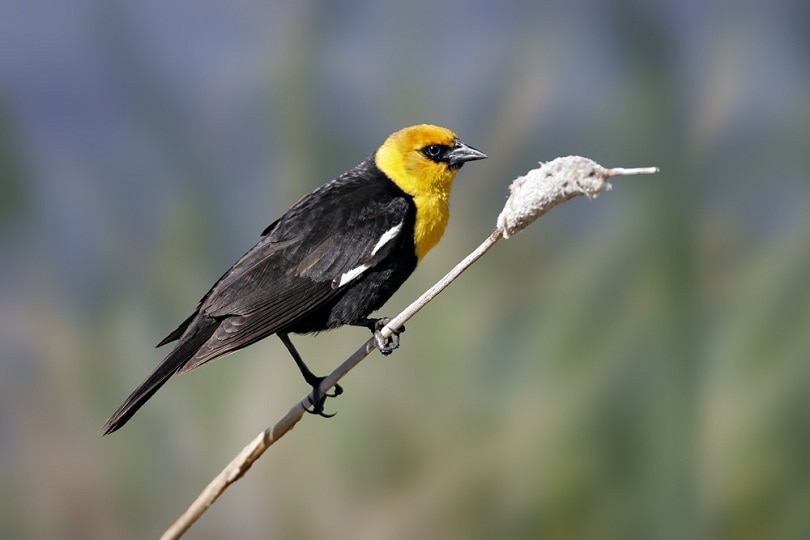
Black birds in North Dakota include species of New England blackbird, grackles, cowbirds, and orioles: all of which are songbirds. But while they might be called black birds, they tend to be more colorful with multi-hued plumage and some iridescent coloring. These birds are generally considered pests, at least agriculturally, because they have a voracious appetite for seeds and plants. However, their bright markings, audible songs, and aeronautic skills make them welcome visitors to many garden feeders.
Below are details of 14 types of black birds in North Dakota, including seasonal visitors and those that are considered accidental sightings that have strayed from neighboring areas.

The 14 Types of Black Birds in North Dakota:
1. Baltimore Oriole

| Latin name: | Icterus galbula |
| Size: | 7 inches |
| Weight: | 1.2 ounces |
The Baltimore Oriole is a migratory bird that is spotted in North Dakota during the summer months before flying south for the colder months. Although its diet consists of insects like beetles and some pests, the Baltimore Oriole also eats crops, including berries and bananas. It is most often seen in woodlands but can be present in parks and gardens, too. This species is very colorful. The male is black and bright orange, and although the female isn’t as brightly colored, she has a yellow belly, brown and yellow head, and brown and white wings.
2. Bobolink

| Latin name: | Dolichonyx oryzivorus |
| Size: | 7 inches |
| Weight: | 1.5 ounces |
The Bobolink is another migratory bird that spends its summer in North Dakota before flying south, typically in October. The male is easy to recognize as it has a black body, black and white wings, and a yellow patch of feathers on the top of the head that looks like a wig. The female has a yellow and brown belly and banded brown wings. They are found in grassland and marshes, depending on the time of year.
3. Brewer’s Blackbird
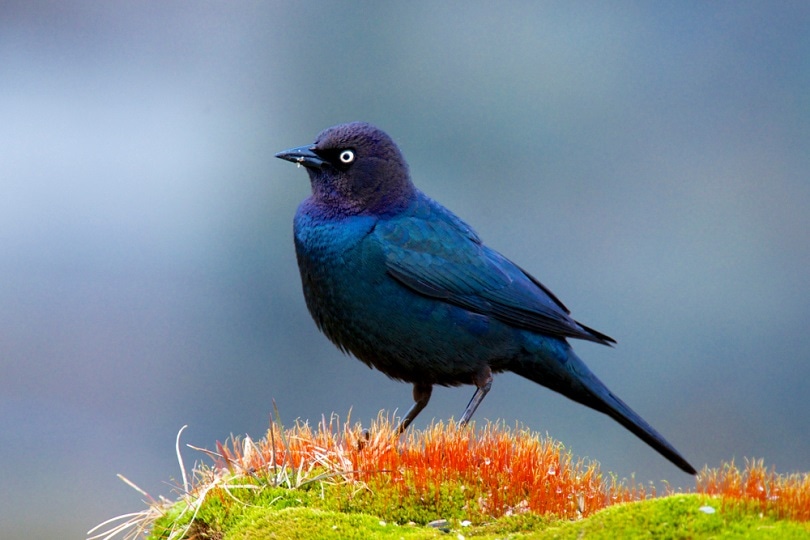
| Latin name: | Euphagus cyanocephalus |
| Size: | 9 inches |
| Weight: | 2.5 ounces |
The Brewer’s Blackbird is usually migratory, although some do remain through winter as well. The males have a black body with a greenish tint, while the females are all brown. They are most often seen in grasslands and marshes and are regular visitors to backyards and parks.
4. Brown-headed Cowbird
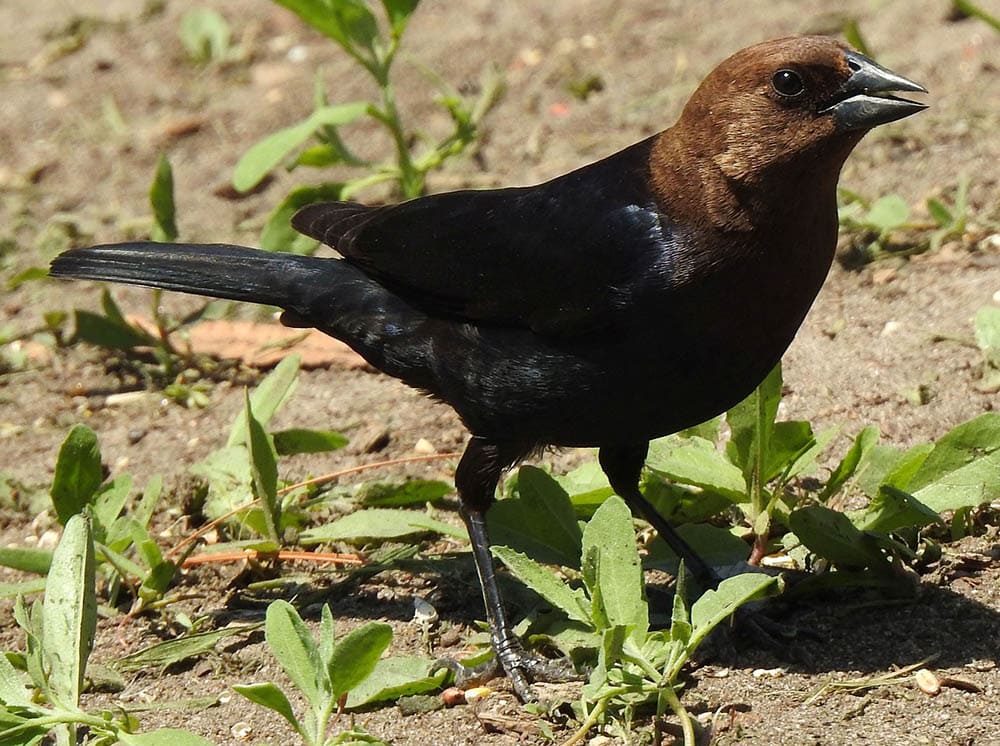
| Latin name: | Molothrus star |
| Size: | 8 inches |
| Weight: | 1.5 ounces |
The Brown-headed Cowbird is commonly seen in North Dakota, although its migratory activities mean that it is only usually seen in the summer months. Males have black bodies and brown heads. Females are brown all over. They can be found in grasslands and, because they are cowbirds, they are regularly found living near or foraging on cattle. Cowbirds will kill the young of other songbirds and make their homes in their nest.
5. Bullock’s Oriole

| Latin name: | Icterus bullockii |
| Size: | 7 inches |
| Weight: | 1.2 ounces |
Bullock’s Orioles are very rarely seen in North Dakota, but their bright colors mean that they are an easy spot if one is in the area. Males have orange bodies, black and white wings, and black and orange heads. Females have brown bodies, banded brown wings, and yellow heads and tails. If you do spot one in North Dakota, it is likely to be in open woodlands.
6. Common Grackle

| Latin name: | Quiscalus quiscala |
| Size: | 12 inches |
| Weight: | 4 ounces |
The Common Grackle is one of the most commonly spotted black birds in North Dakota, and, while most do migrate south for winter, a few remain in the state. They are large by blackbird standards and are easy to identify because they gather in massive flocks and make a lot of noise, although a flock may include other species of birds.
7. Eastern Meadowlark
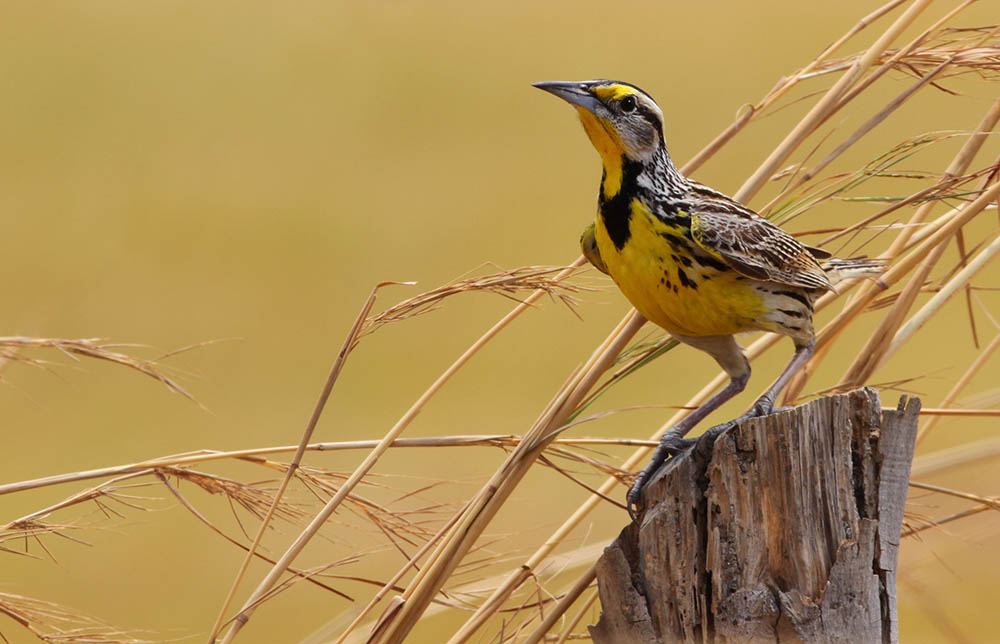
| Latin name: | Sturnella magna |
| Size: | 9 inches |
| Weight: | 4 ounces |
The Eastern Meadowlark is a colorful bird that is not resident in North Dakota but may very rarely be seen in the state. They have a yellow underside, brown and white wings, and a brown, white, and yellow head. If you do spot an Eastern Meadowlark, it is most likely to be in grasslands or meadows, where it will be foraging for insects.
8. European Starling
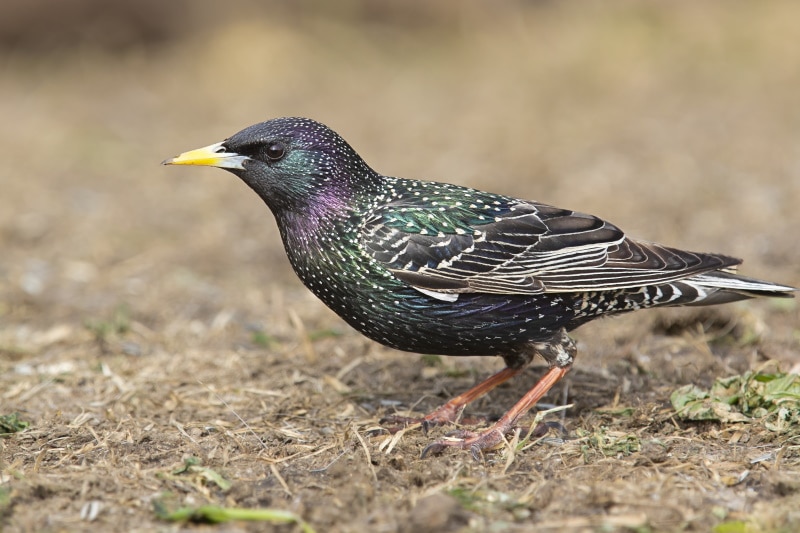
| Latin name: | Sturnus vulgaris |
| Size: | 8 inches |
| Weight: | 3 ounces |
European Starlings have grown considerably in numbers since their introduction, and they are the most commonly spotted black bird in North Dakota during the winter months. They are also commonly seen in summer, but they are considered a pest because they are aggressive and noisy. They feed on insects but also eat fruit and seeds. Although they are considered a pest, the starlings’ murmurations are considered an incredible, natural sight. Thousands of them fly together and in unison, darting and swirling in the sky.
9. Great-tailed Grackle

| Latin name: | Quiscalus mexicanus |
| Size: | 16 inches |
| Weight: | 5.5 ounces |
The Great-tailed Grackle is another accidental species, which means that it most likely found its way to North Dakota by accident, and it is very rare to spot one in the state. They are long birds but relatively lightweight. Males are all black while females are dark brown.
10. Orchard Oriole
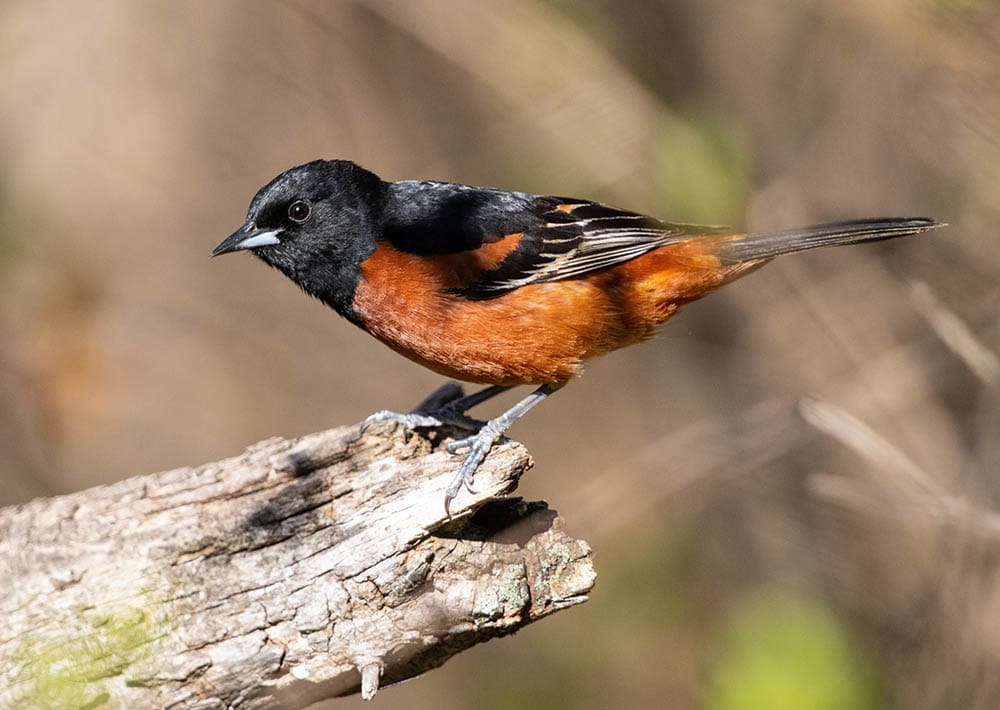
| Latin name: | Icterus spurius |
| Size: | 6.5 inches |
| Weight: | 0.8 ounces |
The Orchard Oriole is considered a pretty little songbird that is often found in orchards, hence its name, but may also be spotted in any open woodland as well as on riverbanks and at backyard feeders. They eat insects and craft hanging nests. The male has a copper brown underside while the rest of it is black. The female is mostly yellow with brown and yellow wings.
11. Red-winged Blackbird
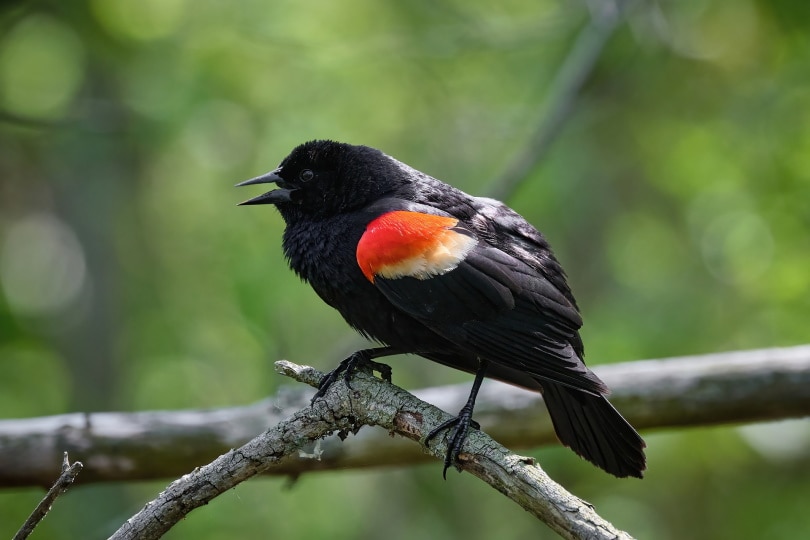
| Latin name: | Agelaius phoenicus |
| Size: | 8 inches |
| Weight: | 2.2 ounces |
The Red-winged Blackbird is the most common summer species of black bird and one of the most common overall. Although they are considered migratory, some do remain for the winter months so they can be spotted all year round. The males are easy to identify because they have black bodies with a red patch and a white line on the wings. The females are brown.
12. Rusty Blackbird
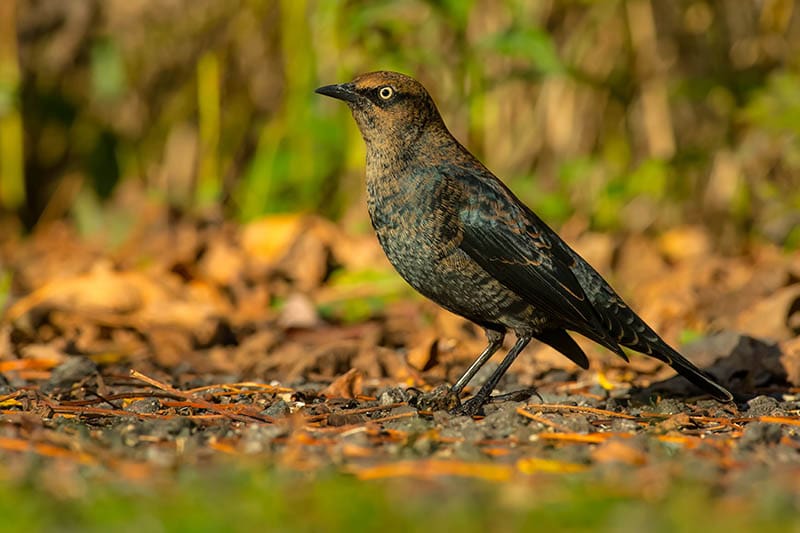
| Latin name: | Euphagus carolinus |
| Size: | 9 inches |
| Weight: | 2.2 ounces |
The Rusty Blackbird is considered vulnerable but can be seen in North Dakota during the winter months. During the summer, the male is all black, but during the winter months, it has rust-looking edges to its feathers. The female is a browner color but has the same brown feather edges. The Rusty Blackbird is usually seen near water, although it is considered a vulnerable species.
13. Western Meadowlark
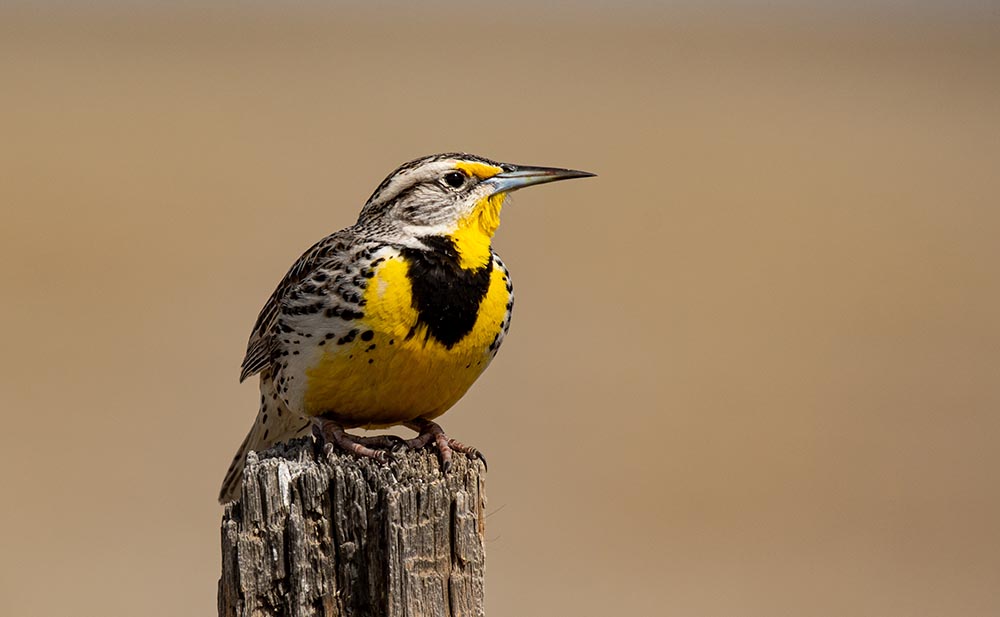
| Latin name: | Sturnella neglecta |
| Size: | 8 inches |
| Weight: | 3.5 ounces |
The Western Meadowlark is a common sight in summer and, because some remain during the winter months, they can be seen all year round—typically in meadows and open grasslands. The bird is quite small and has a brown body with a yellow underbelly and a black mark across its chest.
14. Yellow-headed Blackbird
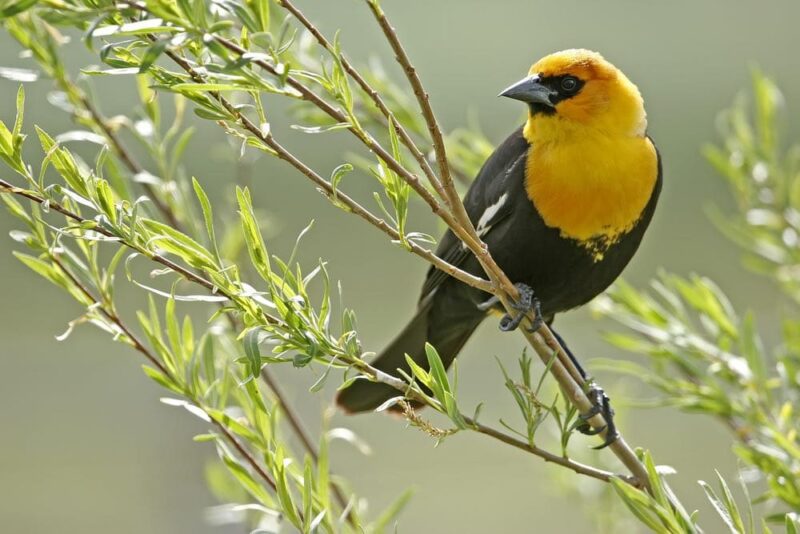
| Latin name: | Xanthocephalus xanthocephalus |
| Size: | 9 inches |
| Weight: | 2.5 ounces |
The Yellow-headed Blackbird is a unique-looking blackbird with a black body and bright yellow head. Females have a similar appearance except they are brown with a lighter yellow head. They are found in wetlands and grasslands and can be seen primarily in summer, although a small number do remain in winter so can be seen year-round.

Final Thoughts
Although black birds are considered a pest by many gardeners and farmers, as well as those that dislike the noise that a large flock of blackbirds can make, these songbirds are colorful and intelligent. Most can be attracted to garden feeders and are fun and educational to watch. Of the 14 types of black birds listed above, North Dakota residents are most likely to see the Red-winged Blackbird, although the European Starling is more common during the winter months, so this is a common sight, too.
Featured Image Credit: Kenneth Rush, Shutterstock
Table of Contents
About the Author Robert Sparks
Robert’s obsession with all things optical started early in life, when his optician father would bring home prototypes for Robert to play with. Nowadays, Robert is dedicated to helping others find the right optics for their needs. His hobbies include astronomy, astrophysics, and model building. Originally from Newark, NJ, he resides in Santa Fe, New Mexico, where the nighttime skies are filled with glittering stars.
Related Articles:
Monocular vs Telescope: Differences Explained (With Pictures)
10 Types of Hummingbirds in Arkansas (With Pictures)
8 Types of Hummingbirds in Nebraska (With Pictures)
5 Types of Hummingbirds in Idaho (With Pictures)
3 Types of Hummingbirds in Mississippi (With Pictures)
8 Types of Hummingbirds in Kansas (With Pictures)
5 Types of Hummingbirds in West Virginia (With Pictures)
5 Types of Hummingbirds in Ohio (With Pictures)
